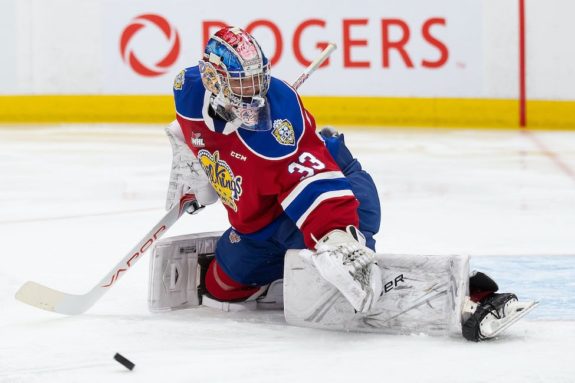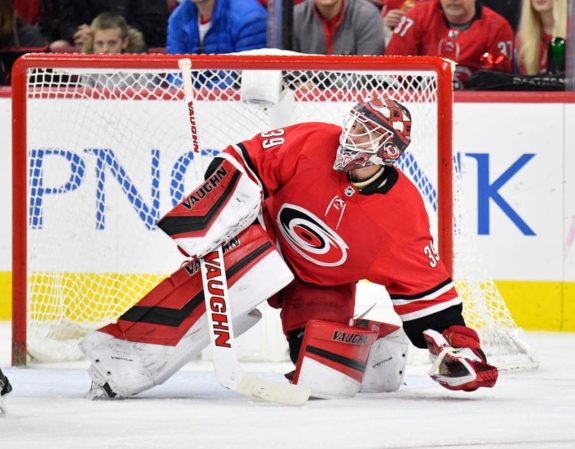The thought of the Detroit Red Wings drafting goalie Sebastian Cossa in the first round of the 2021 NHL Entry Draft was not far-fetched, so it came as no surprise when general manager Steve Yzerman selected him on Friday. How it unfolded, though, caught everyone off guard.
Yzerman reached into his bag of tricks just moments before the Dallas Stars were set to select at 15th overall, agreeing to trade the team’s first-rounder (23rd overall), a second-rounder (48th overall), and a fifth rounder (138th overall) in exchange for the rights to pick No. 15. And with top-goalie prospect Jesper Wallstedt still available, the hockey world expected to hear his name.
As he’s done so often during his tenure as Red Wings GM, Yzerman surprised the masses.
Related: Red Wings Fill Huge Needs on Night One of Draft
The biggest question in all of this isn’t necessarily around the selection of Cossa over Wallstedt, because either goalie is likely to have a long-term impact with their respective club. The question that remains asks why the Red Wings decided to trade up at all, considering it’s possible (though it can never be certain) that Cossa would have been available without making a move.
The answer isn’t easy, and there’s quite a bit to consider.
There was Massive Interest in Sebastian Cossa
One thing should be made clear up front: None of us have any idea of what conversations were held behind closed doors, and to state the painfully obvious truth, we may never know what led Detroit’s brass to seek out a higher pick. The impact of this won’t be known for years, but examining the caliber of goalie Cossa is helps garner an understanding of why the Red Wings were eager to snag the 18-year-old.
For starters, Cossa is revered as an incredibly mature goalie with a strong hockey sense, and at 6-foot-6-inches tall and 212 pounds has a frame that takes up most of the net, even when down in the butterfly. He’s athletic, a proven winner, and it’s generally agreed upon that he will develop into an NHL goalie. His talent speaks for itself, and his eye-popping 17-1-1 record, 1.57 goals-against average (GAA), and .941 save percentage last season are enough to whet any GM’s appetite.
With all of that said, why move up to draft a goalie that could have still been available? Simply put — the Red Wings made the move to ensure they could get the player they wanted, and had zero assurances that Cossa would remain available. In fact, recent reports had even suggested that Cossa had surpassed Wallstedt on multiple draft boards.

The fact that Detroit passed on Wallstedt is irrelevant, because Yzerman has shown time after time that he’s not afraid to break rank. On top of that, the Red Wings really didn’t give up that much to begin with. The first-round picks cancel out, so essentially all Detroit lost in this deal were picks 48 and 138.
Small price to pay — especially when you already have a stocked cupboard — to get what many perceive as a franchise cornerstone.
Alex Nedeljkovic Addition Not Enough To Bank On
One last question that lingers revolves around the recent addition of Alex Nedeljkovic, and why the team would be so eager to add a goalie when they just traded for (and signed) the Calder Trophy Finalist.
That one’s easy — there are no guarantees. The 25-year-old is on a two-year deal, and still unproven in the scheme of things. Though the trade is a good gamble by Yzerman considering Nedeljkovic’s 2.17 GAA and .920 save percentage in last season’s playoffs (and it was even better in 23 regular season games), it was also clear that the Carolina Hurricanes had moved on.
Whether or not Nedeljkovic works out in the long term shouldn’t even be considered at this point, because it’s not relevant. By selecting their prized goalie prospect now, the Red Wings will allow Cossa to develop his game for a few seasons, as opposed to rushing him through the ranks.

It should also be noted that the Minnesota Wild, who traded up themselves to select at No. 20, ultimately snagged Wallstedt, so there is no guarantee there would have been any goalies for the Red Wings to take just a few picks later.
The timing was right, the pieces were in place, and the team made a deliberate decision to go get its future goalie, before someone else did.
The Answer is Glaringly Obvious
It’s clear Yzerman had at least some sort of inkling that Cossa was at risk of being selected by another team, so he pounced, though the most important thing to remember is he’s followed this blueprint before.
Related: 2021 NHL Draft Tracker
Yzerman drafted goalie Andrei Vasilevskiy 19th overall in 2012 with the Tampa Bay Lightning, and in the ensuing season fellow netminder Ben Bishop made his first appearance with the team. Four seasons later Bishop was on his way out the door, and Vasilevskiy stepped into the starting role.
Four years after that, with a Vezina Trophy, a Conn Smythe Trophy, and back-to-back Stanley Cup championships under his belt, Vasilevskiy is proof that Yzerman’s method of building a team is effective at the very least, and he’s trying to recreate that result in the Motor City.
Time will tell.